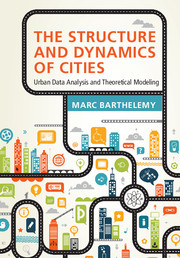Book contents
3 - The spatial organization of cities
Published online by Cambridge University Press: 10 November 2016
Summary
The locations of homes, activities, and businesses shape a city, and identifying the mechanisms that govern these spatial distributions is crucial for our understanding of these systems. We present here some recently discussed aspects, which may provide a basis for further insights.We will begin with a discussion on the location of stores and facilities, which are very likely governed by optimal considerations.
We will then discuss the polycentric aspects of cities by starting with their identification and measures. We will describe how to characterize and measure an activity center – a “hotspot” – defined as a local maximum of the activity density. The important empirical result is that the number of these hotspots scales sublinearly with the population size.
We continue by describing two classical theoretical models for polycentricity: the Fujita–Ogawa model, proposed in the 1980s, which relies on the idea that agglomeration effects are responsible for polycentricity, and the edge-city model proposed by Krugman. As we shall see, these models cannot, however, explain the scaling of the number of hotspots with population and this leads us to reconsider the classical Fujita–Ogawa model in order to derive a result in agreement with empirical observations.
Optimal locations
Distribution of public facilities
Public facilities such as airports, post offices, and hospitals have to be distributed according to the local population density in order to optimize their efficiency. These facilities constitute an important part of the urban structure and help to shape the spatial distribution of population. It is therefore important to understand the organization of these particular places.
We can measure these spatial distributions, and the natural null model to compare against these empirical observations is the optimal case where the average distance from an individual to the nearest facility is minimized (Gastner and Newman 2006), and we follow here the derivation given by Gusein-Zade (1982).
- Type
- Chapter
- Information
- The Structure and Dynamics of CitiesUrban Data Analysis and Theoretical Modeling, pp. 47 - 77Publisher: Cambridge University PressPrint publication year: 2016
- 1
- Cited by



